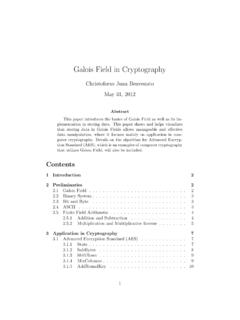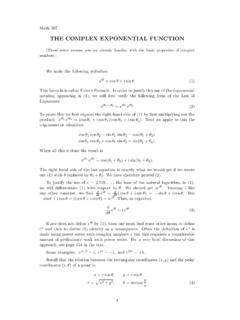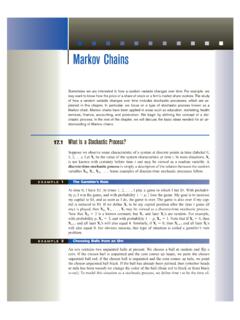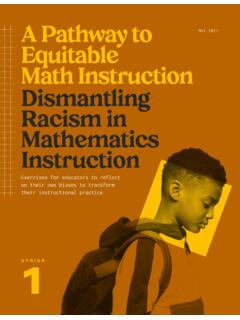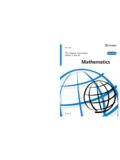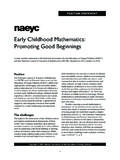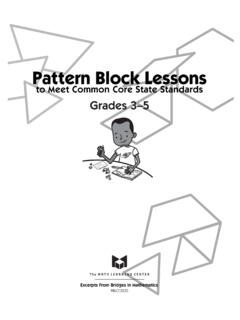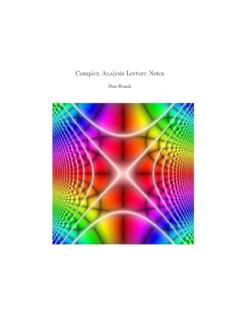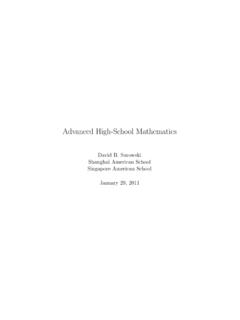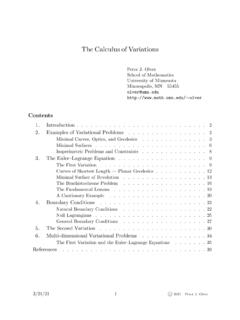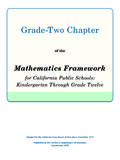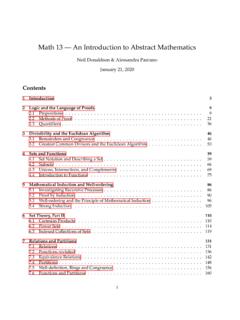Transcription of Precalculus - University of Washington
1 PrecalculusPrecalculusDavid H. CollingwoodDepartment of MathematicsUniversity of WashingtonK. David PrinceMinority Science and Engineering ProgramCollege of EngineeringUniversity of WashingtonMatthew M. ConroyDepartment of MathematicsUniversity of WashingtonSeptember 2, 2011iiCopyrightc 2003 David H. Collingwood and K. David Prince. Copyrightc 2011 David H. Collingwood, K. David Prince, and Matthew M. Conroy. Permission isgranted to copy, distribute and/or modify this document under the terms of theGNU Free Documentation License, Version or any later version published bythe Free Software Foundation; with no Invariant Sections, with no Front-Cover,and with no Back-Cover Texts. A copy of the license is included in thesectionentitled GNU Free Documentation License.
2 Author NoteFor most of you, this course will be unlike any mathematics course youhave previously encountered. Why is this?Learning a new languageColleges and universities have been designed to help us discover, shareand apply knowledge. As a student, the preparation requiredto carry outthis three part mission varies widely, depending upon the chosen field ofstudy. One fundamental prerequisite is fluency in a basic language ;this provides a common framework in which to exchange ideas,care-fully formulate problems and actively work toward their solutions. Inmodern science and engineering, college mathematics has become this basic language , beginning withprecalculus, moving intocalculusandprogressing into more advanced courses.
3 The difficulty is that collegemathematics will involve genuinely new ideas and the mystery of thisunknown can be sort of intimidating. However, everyone in this coursehas the intelligence to succeed!Is this course the same as high school Precalculus ?There are key differences between the way teaching and learning takesplace in high schools and universities. Our goal is much morethan justgetting you to reproduce what was done in the classroom. Hereare somekey points to keep in mind: The pace of this course will be faster than a high school classinprecalculus. Above that, we aim for greater command of the ma-terial, especially the ability to extend what we have learned to newsituations. This course aims to help you build the stamina required to solvechallenging and lengthy multi-step problems.
4 As a rule of thumb, this course should on average take 15 hoursof effort per week. That means that in addition to the 5 classroomhours per week, you would spend 10 hours extra on the class. Thisis only an average and my experience has shown that 12 15 hoursiiiivof study per week (outside class) is a more typical otherwords, for many students, this course is the equivalent of a half-time job! Because the course material is developed in a highly cumulativemanner, we recommend that your study time be spread out evenlyover the week, rather than in huge isolated blocks. An analogy withathletics is useful: If you are preparing to run a marathon, you musttrain daily; if you want to improve your time, you must continuallypush your comfort course assumes prior exposure to the mathematics in Chapters1-12; these chapters cover functions, their graphs and somebasic exam-ples.
5 This material is fully developed, in case you need to brush up on aparticular topic. If you have never encountered the conceptof a function,graphs of functions, linear functions or quadratic functions, this coursewill probably seem too advanced. You are notassumed to have takena course which focuses on mathematical problem solving or multi-stepproblem solving; that is the purpose of this is a great deal of archived information specific to thiscourse thatcan be accessed via the World Wide Web at the URL m120 Why are we using this text?Prior to 1990, the performance of a student in Precalculus atthe Univer-sity of Washington was not a predictor of success in calculus. For thisreason, the mathematics department set out to create a new course witha specific set of goals in mind: A review of the essential mathematics needed to succeed in calculus.
6 An emphasis on problem solving, the idea being to gain both experi-ence and confidence in working with a particular set of mathemati-cal text was created to achieve these goals and the 2004-05 academicyear marks the eleventh year in which it has been used. Several thou-sand students have successfully passed through the , Answers, book is full of worked out examples. We use the the notation Solu-tion. to indicate where the reasoning for a problem begins; the symbol is used to indicate the end of the solution to a problem. Thereis a Tableof Contents that is useful in helping you find a topic treated earlier inthe course. It is also a good rough outline when it comes time to studyfor the final examination.
7 The book also includes an index at the , there is an appendix at the end of the text with answers to mostof the problems in the text. It should be emphasized these are answers as opposed to solutions . Any homework problems you may be asked toturn in will require you include all your work; in other words, a detailedsolution. Simply writing down the answer from the back of thetext wouldnever be sufficient; the answers are intended to be a guide to help insureyou are on the right to succeed in math people learn mathematics by doing mathematics. That is, you learnit by active participation; it is very unusual for someone tolearn the ma-terial by simply watching their instructor perform on Monday, Wednes-day, and Friday.
8 For this reason, the homework is THE heart ofthecourse and more than anything else, study time is the key to successin math advise 15 hours of study per week, outside , during the first week, the number of study hours will probably beeven higher as you adjust to the viewpoint of the course and brush upon algebra are some suggestions: Prior to a given class, make sure you havelooked over the reading assigned. If you can t finish it, at least look it overand get some idea of the topic to be discussed. Having looked over thematerial ahead of time, you will get FAR MORE out of the lecture. Then,after lecture, you will be ready to launch into the you followthis model, it will minimize the number of times you leave class in a addition, spread your study time out evenly over the week,rather thanwaiting until the day before an assignment is efforts of numerous people have led to many changes, correctionsand improvements.
9 We want to specifically thank Laura Acu na, PatrickAverbeck, Jim Baxter, Sandi Bennett, Daniel Bjorkegren, Cindy Burton,Michael D. Calac, Roll Jean Cheng, Jerry Folland, Dan Fox, Grant Gal-braith, Peter Garfield, Richard J. Golob, Joel Grus, Fred Kuczmarski,Julie Harris, Michael Harrison, Teri Hughes, Ron Irving, Ian Jannetty,Mark Johnson, Michael Keynes, Andrew Loveless, Don Marshall, LindaviMartin, Alexandra Nichifor, Patrick Perkins, Lisa Peterson, Ken Plochin-ski, Eric Rimbey, Tim Roberts, Aaron Schlafly, David Schneider, MarilynStor, Lukas Svec, Sarah Swearinger, Jennifer Taggart, Steve Tanner, PaulTseng, and Rebecca Tyson. I am grateful to everyone for theirhard workand dedication to making this a better product for our Minority Science and Engineering Program (MSEP) of the Col-lege of Engineering supports the development of this textbook.
10 It is alsoauthoring additional materials, namely, a student study guide and aninstructor guide. MSEP actively uses these all of these materials in itssummer mathematics program for freshman pre-engineers. Wewant tothank MSEP for its contributions to this want to thank Intel Corporation for their grant giving us an Inno-vation in Education server donation. This computer hardware was usedto maintain and develop this comments, corrections, and ideas you ever noticed this peculiar feature of mathematics:When youdon t know what is going on, it is really hard, difficult, and , when you know what is going on, mathematics seems incrediblyeasy, and you wonder why you had trouble with it in the first place!

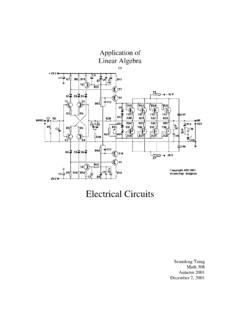
![ZZ dA R [0 2] R - University of Washington](/cache/preview/6/4/c/c/9/f/d/6/thumb-64cc9fd6ac93e2995c04a2a74b217176.jpg)
